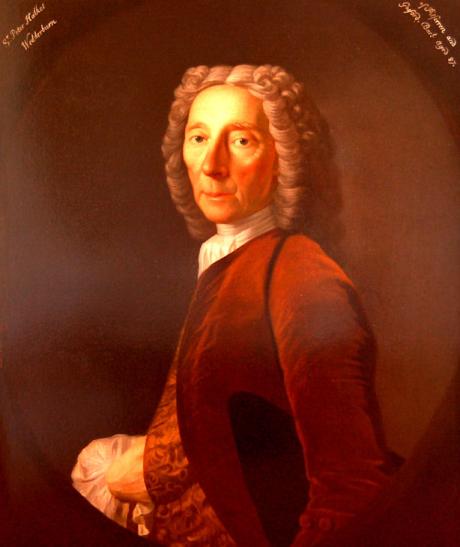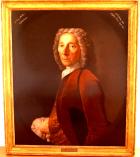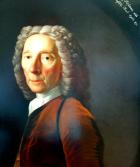Private Collection, Delaware, USA
.
The Portrait of Sir Peter in his 87th year and in the year that he died was painted in 1746. The portrait hints at a deeper intimate meaning in the relationship with the sitter and the artist. Sir Peter and his father were family friend's of the artist and his father. Allan Ramsay's father was the succesful Poet and Bookseller also baring the same name ( Allan Ramsay 1684-1758). It was Sir Peter and his son who helped the artist's father finance his sons further studies in Italy in 1735, 11 years before this portrait was painted where they put up 2000 merks to finance ramsay's travel and education.
There is another version of this portrait in the Scottish National Portrait Gallery. Sir Peter Halket, BT, of Pitferen and Gosford 1659-1746 b. c.1660, 2nd s. of Sir Peter Wedderburn of Gosford, Ld. Gosford SCJ, by his 2nd w. Agnes, da. of John Dickson of Hartree, Peebles, Ld. Hartree SCJ. educ. St. Andrews Univ. 1675. m. 1694 Janet (d. 1713), da. and event. h. of Sir Charles Halkett, 1st Bt., of Pitfirrane, 7s. (2 d.v.p.) 5da. (2 d.v.p.). cr. Bt. 31 Dec. 1697; suc. bro. to Gosford 1688, bro.-in-law to Pitfirrane and assumed name of Halkett 1705.1 Offices Held Lt. R. Reg. Ft. 1686, capt. 1688. Burgess, Glasgow 1700, Perth 1709; provost, Dunfermline 1705–34.2 MP Dunfermline 1705–7. Commr. visitation, St. Andrews Univ. 1718. Wedderburn’s father was an eminent royalist lawyer, who was fined under the Protectorate, but succeeded in uniting his extensive Haddingtonshire properties as the barony of Gosford in 1659. Knighted at the Restoration, he was appointed to the court of session as Lord Gosford in 1668. On Gosford’s death in 1679, the estate passed to his eldest son, who was drowned at sea in 1688. Wedderburn therefore succeeded, and chose to abandon his military career.
He was made a baronet in 1697, and in 1705 his wife’s inheritance of Pitfirrane in Fifeshire gave him sufficient influence to enter the Scottish parliament for Dunfermline, where he succeeded his late brother-in-law, Sir James Halkett, 2nd Bt. Wedderburn now assumed the surname Halkett. His first political forays, following in his predecessor’s footsteps, were as a Country oppositionist, but he later joined the Squadrone. He voted the party line of qualified support for the Union and was included in the Squadrone contingent of representatives to the first Parliament of Great Britain.3 Halkett was not a particularly active Member at Westminster, securing only two appointments to drafting committees: to repeal the Scottish act of security (4 Dec. 1707) and to deter disloyal clan chiefs (11 Feb.). Only one speech is known, which survives as an undated copy in his own hand. It relates to George Baillie’s motion, in a committee of the whole on 29 Nov. 1707, for the abolition of the Scottish privy council, but (despite being addressed to ‘this honourable committee’) may have been delivered upon the report of this resolution on 11 Dec. Despite such uncertainties, the speech clearly indicates that Halkett was a Squadrone supporter: A separate council in Scotland will be dangerous not only to that part of Britain, but to the whole island; the many attempts upon our liberty . . . committed by a council in Scotland have been so fully represented by many worthy Members, that even those who have spoke for continuing of it there, are of opinion that it should be but for a time, so that I believe there is not one in this House who is not persuaded of the necessity of laying it aside some time or other, the only debate which remains, is when that should be done . . . The solid foundation of a peaceable and lasting government is most firmly established upon the hearts of the people, who will not refuse to submit to wholesome laws, when by the just execution of them the subjects are made sensible that they conduce to the happiness and advantage of the whole body politic . . . It is love and affection to the government which makes it happy and secure; how this love, this affection is to be purchased by a separate council, is what I cannot understand. The apprehensions of a council which had been in use to exercise so much arbitrary power, may establish terror but never love . . . The most effectual way of procuring that peace and quiet, which all good men wish for, is to put us under the same government with England; nobody is ignorant of the happiness of its constitution, under which the subject enjoys liberty and property, and the monarch can put the laws into execution with safety . . . If the use of a separate council be easy to keep the peace, which is all that is pretended, . . . that may be done with greater safety by other judicatures, which being diffused through the whole nation, the great body of the nobility and gentry will apply themselves to preserve the common security, when they are fully entrusted with putting the laws into execution, and when there is no separate council to discourage them from doing their duty.
Apart from references to Halkett socializing with Squadrone leaders, no further evidence of his activities at Westminster has been discovered. He returned to Scotland shortly before the prorogation and was present at a meeting of Fifeshire freeholders on 20 Mar. 1708, when he supported Lord Rothes over a loyal address to the crown. His deference to the Squadrone leadership was also evident in his willingness to support, via his Dunfermline interest, the candidacy for Stirling Burghs of Lord Yester, the Marquess of Tweeddale’s son. It had been mooted, as part of this arrangement, that Halkett himself might stand for another district of burghs or even for Fifeshire, but nothing came of this. He continued to enjoy the favour of Rothes, who desired his candidacy for a subsequent Fifeshire by-election. Halkett rejected this suggestion, and is not known to have stood on any subsequent occasion. His eldest son, Peter, successfully contested Stirling Burghs in 1734. Halkett died on 20 Mar. 1746 and was buried in Dunfermline Abbey. Under the provisions of entails made in 1706, which later gave rise to protracted litigation, the estate of Pitfirrane and the name of Halkett passed to the eldest son, whereas Gosford went to the second son, Charles, who retained the Wedderburn name.
Allan Ramsay was born in Edinburgh, Scotland, the eldest son of Allan Ramsay, poet and author of The Gentle Shepherd. From the age of twenty he studied in London under the Swedish painter Hans Hysing, and at the St. Martin's Lane Academy; leaving in 1736 for Rome and Naples, where he worked for three years under Francesco Solimena and Imperiali (Francesco Fernandi).
On his return in 1738 to the British Isles, he first settled in Edinburgh, attracting attention by his head of Duncan Forbes of Culloden and his full-length portrait of the Duke of Argyll, later used on Royal Bank of Scotlandbanknotes.
He later moved to London, where he was employed by the Duke of Bridgewater. His pleasant manners and varied culture, not less than his artistic skill, contributed to render him popular. His only serious competitor was Thomas Hudson, with whom he shared a drapery painter, Joseph van Aken. In 1739 he married his first wife, Anne Bayne, the daughter of a professor of Scots law at Edinburgh, Alexander Bayne of Rires (c.1684–1737), and Mary Carstairs (1695?–1759). None of their 3 children survived childhood, and she died on 4 February 1743 giving birth to the third of them.
One of his drawing pupils was Margaret Lindsay, eldest daughter of Sir Alexander Lindsay of Evelick and Amelia Murray (granddaughter to David Murray, 5th Viscount of Stormont and sister to the naval officer John Lindsay). He later eloped with her and on 1 March 1752 they married in the Canongate Kirk, Edinburgh; her father never forgave her for marrying an artist. Ramsay already had to maintain a daughter from his previous marriage and his two surviving sisters, but told Sir Alexander that he could provide Margaret with an annual income of £100. He said it would increase ‘as my affairs increase, and I thank God, they are in a way of increasing’ and that his only motive for the marriage was ‘my love for your Daughter, who, I am sensible, is entitled to much more than ever I shall have to bestow upon her’.[1] Three children survived from their long and happy marriage, Amelia (1755–1813), Charlotte (1758–1818?), and John (1768–1845).
Ramsay and his new wife spent 1754–1757 together in Italy, going to Rome, Florence, Naples and Tivoli, researching, painting and drawing old masters, antiquities and archaeological sites. He also earned income painting Grand Tourists' portraits. This and other trips to Italy involved more literary and antiquarian research than art. After their return, Ramsay in 1761 was appointed to succeed John Shackelton as Principal Painter in Ordinary to George III, beating Hudson to the post. The king commissioned so many royal portraits to be given to ambassadors and colonial governors, that Ramsay used the services of numerous assistants—of whom David Martin and Philip Reinagle are the best known.
He gave up painting in about 1770 to concentrate on literary pursuits. His health was shattered by an accidental dislocation of the right arm and his second wife's death in 1782. With unflinching pertinacity, he struggled until he had completed a likeness of the king upon which he was engaged at the time, and then started for his beloved Italy. He left a series of 50 royal portraits to be completed by his assistant Reinagle. For several years he lingered in the south, his constitution finally broken. He died at Dover on 10 August 1784.
Among his most satisfactory productions are some of his earlier ones, such as the full-length of the duke of Argyll, and the numerous bust-portraits of Scottish gentlemen and their ladies which he executed before settling in London. They are full of both grace and individuality; the features show excellent draughtsmanship; and the flesh-painting is firm and sound in method, though frequently tending a little to hardness and opacity. His full-length of Lady Mary Coke is remarkable for the skill and delicacy with which the white satin drapery is managed; while the portrait of his brown-eyed second wife Margaret, in the Scottish National Gallery, is described as having a sweetness and tenderness. The portrait of his wife also shows the influence of French art, which Ramsay incorporated into his work. The large collection of his sketches in the possession of the Royal Scottish Academyand the Board of Trustees, Edinburgh also show this French elegance and soft colours.
In a documentary broadcast by the BBC in February 2014, Ramsay was shown to be the artist who painted the lost portrait of Charles Edward Stuart in 1745, completed on the verge of his invasion of England.Ramsay has paintings in the collection of a few British institutions including the National Gallery in London, Sheffield, Derby Art Gallery (attributed), Glasgow Museum and Newstead Abbey.



